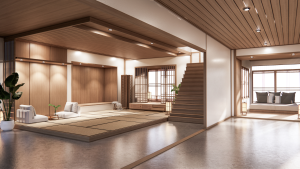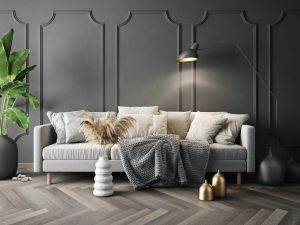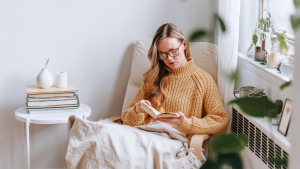Creating a gallery wall with personal artwork can transform a space and reflect individual style. To start, gather a variety of framed pieces that hold significance, such as family photos, travel mementos, or original artwork. This collection will serve as the foundation of the gallery wall, allowing for a mix of colors and shapes that add visual interest.
Planning the arrangement is crucial. They should consider the wall space and layout, opting for a cohesive design that flows well. Using painter’s tape to outline the intended arrangement on the wall can help visualize the final look before committing to any nail holes.
Finally, layering artwork with different sizes and orientations can create dynamic visual appeal. By incorporating personal touches and unique pieces, the gallery wall becomes not just a decoration, but a storytelling element that enhances the overall atmosphere of a room.
Planning Your Gallery Wall
Creating a gallery wall involves careful consideration of wall space and selection of artwork. This section provides guidance on choosing the right spot, selecting diverse pieces, and arranging them for maximum impact.
Choosing the Right Wall Space
Selecting the appropriate wall is crucial for a successful gallery wall. An ideal wall should be spacious enough to accommodate multiple pieces without feeling cluttered. Look for prominent walls in living rooms, hallways, or near staircases.
It is essential to consider the wall’s visibility. A space that is frequently seen, such as above a sofa or in an entryway, maximizes the artwork’s impact. Also, make sure the wall receives enough light to enhance the colors of the prints and photographs.
Selecting Artwork and Photographs
Art selection can significantly influence the theme of a gallery wall. Begin by gathering a mix of personal artwork, illustrations, and photographs. This variety adds depth and interest.
Consider the color palette and style of each piece. Coordinating colors can create a cohesive look. Framed art can tie different elements together, while unframed prints introduce a more casual vibe. Layout options can be playful or formal, but maintaining a consistent frame style helps unify the display.
Arranging Your Pieces
Arrangement plays a key role in visual appeal. Start by laying out the pieces on the floor to experiment with different configurations. This approach allows for easy adjustments and alignment.
A grid layout offers symmetry, while an asymmetrical layout can add a more dynamic feel. Make use of larger pieces as focal points and surround them with smaller works for balance.
When hanging, maintain consistent spacing between frames, typically 2 to 4 inches, to create a polished look. Use a level to ensure everything is aligned properly, enhancing the overall presentation.
Design Strategies for Visual Impact
Creating a gallery wall that captivates the eye involves thoughtful design strategies. Focusing on the combination of various art forms and thoughtful color choices can result in a striking display.
Mixing Art Forms and Sizes
To achieve visual dynamism, one should mix different art forms such as paintings, photographs, and prints. This combination adds depth and interest. Incorporating diverse frame styles enhances the uniqueness of the display.
Consider varying the sizes of the artwork. A balance between large statement pieces and smaller works creates an engaging flow. For example, placing a large framed art piece as the focal point can draw attention. Then, surrounding it with smaller pieces can guide the viewer’s gaze across the wall.
An arrangement that plays with unexpected shapes and dimensions invites exploration. Using a grid layout provides structure, while an organic arrangement adds spontaneity.
Color and Contrast Considerations
Color plays a pivotal role in the overall feel of the gallery wall. It is essential to consider both the hues of the artwork and the space’s existing color scheme.
Utilizing a cohesive color palette can unify diverse pieces. This can be achieved through common tones or complementary colors.
Incorporating contrast is equally important. Pairing bold colors with subtler tones adds visual interest. For example, a vibrant piece can stand out against a neutral background, making it a focal point.
Accent pieces in contrasting colors can draw the eye and create a dynamic effect. Different textures can also contribute by adding layers, such as glossy frames next to matte finishes, enhancing the visual experience.
Installation Tips for Your Gallery Wall
Creating a stunning gallery wall requires careful planning and execution. Effective installation techniques can enhance the display of personal artwork, family photos, and cherished mementos.
Using Paper Templates
Before making holes in the wall, using paper templates is a practical step. Cut out paper pieces that match the dimensions of each artwork. This method allows for easy arrangement without commitment.
Next, use painter’s tape to adhere the paper templates to the wall. This helps visualize spacing and alignment. Adjust the positions until achieving the desired layout.
Consider mixing different frame styles and sizes while maintaining a cohesive look. The templates make it simple to experiment with placement. Once satisfied with the arrangement, mark the spots for hanging.
Hanging Your Artwork
When hanging artwork, choose the right hardware based on the weight of the pieces. For heavier frames, wall anchors or screws provide stability. For lighter pieces, nails or adhesive strips may suffice.
Start with the center piece of the arrangement, as it sets the tone. Measure and mark the height so that the artwork hangs at eye level, usually around 57 to 60 inches from the floor.
From there, hang additional pieces using the prepared marks from the paper templates. Step back regularly to ensure the layout remains balanced. It’s important to adjust as necessary for a visually pleasing display that showcases personal items effectively.




